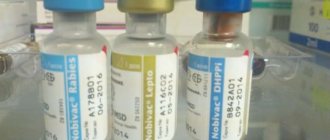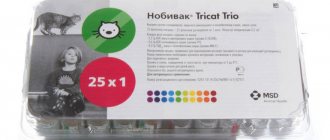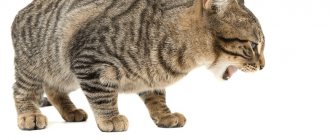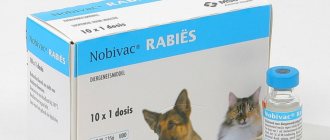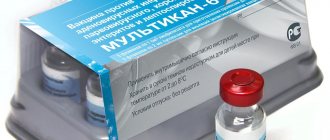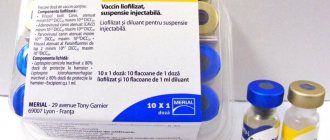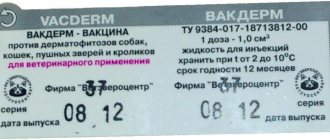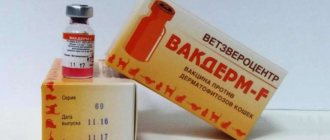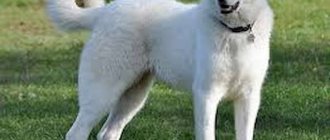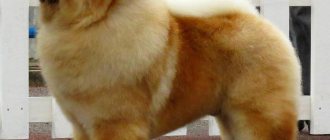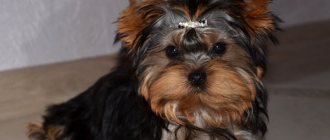The Nobivak vaccine is one of the most popular. It is widely distributed, in most cases well tolerated by animals and is reasonably priced. But there are reviews of severe adverse reactions to some batches of serum, including anaphylactic shock and death.
In this review, we’ll look at what types of Nobivak vaccines for dogs exist, how well they work, what scheme to use for vaccinating dogs, and what negative effects are possible.
At the end of the article you will find reviews from owners, answers to frequently asked questions and a list of analogues with prices.
Descriptions and prices are current as of November 2022 and are constantly updated.
Types of vaccines
Nobivac vaccines are produced by the Dutch veterinary company MSD Animal Health, and are represented in Russia by the Intervet branch. The organization produces 8 types of serums for dogs, each of which helps develop immunity against certain diseases.
DHPPi
Nobivac DHPPi is Intervet’s most popular serum. This dry inactivated vaccine is aimed at preventing infection:
- plague;
- infectious hepatitis;
- parvovirus enteritis;
- parainfluenza.
Each dose of DHPPi contains:
- 4.0 lg TCD50 of canine distemper virus;
- 4.0 lg TCD50 adenovirus;
- 7.0 lg TCD50 parvovirus;
- 5.5 lg TCD50 of parainfluenza virus.
After a two-time administration (with a break of 21-30 days) of Nobivac DHPPi for 10 days, the dog develops strong immunity against these viruses. Protection is provided for up to 12 months.
One dose of DHPPi costs 300 rubles on average.
Rabies
Rabies is a monovalent drug against the rabies virus in the form of a suspension for injection. Made from the culture fluid of the continuous cell line BHK-21 clone CT, infected with the Pasteur RIV strain and inactivated with ß-propiolactone.
Nobivac Rabies creates lasting protection against rabies after a single dose for up to 3 years.
1 bottle costs about 130 rubles.
Lepto
Also a monovalent drug in the form of a suspension. Protects against leptospirosis. 1 ml of the drug (one immunizing dose) contains leptospira of the Canicola (strain Ca-12-000) and Icterohaemorrhagiae (strain 820K) serogroups.
Immunity against leptospirosis in dogs is developed 3 weeks after administration of Lepto and lasts up to one year.
Average price 85 rub.
R.L.
Nobivac RL combines 2 previous vaccinations. The product works simultaneously against rabies and leptospirosis viruses.
Each dose contains inactivated rabies virus (strain Pasteur RIV) and cultures of Leptospira interrogans: serogroups Canicola (strain Ca-12-000) and Icterohaemorrhagiae (strain 820K).
Immunity after injection is developed after 2-3 weeks RL. The vaccine protects the dog for 3 years from rabies and up to a year from leptospirosis.
The average cost of one bottle is 235 rubles.
L4
Another remedy in the form of a suspension for leptospirosis. It differs from the Lepto variety in that it prevents infection from more viruses. So, 1 ml contains at least:
- 2200 IU Leptospira: L. Canicola serovar Portland-vere (strain Ca-12-000);
- 210 units Icterohaemorrhagiae serovar Copenhageni (strain Ic-02-001);
- 420 IU L. Australis serovar Bratislava (strain As-05-073);
- 350 IU L. Grippotyphosa serovar Dadas (strain Gr-01-005).
Nobivac L4 promotes the development of immunity to 6 different types of Leptospira, and also prevents their excretion in the urine, which reduces the risk of infection to other animals and people. Protection lasts 1 year after double vaccination.
L4 sells for an average of 220 rubles.
Puppy DP
Puppy DP is the only variety of Nobivac intended only for puppies . Available in dry form (in the form of a lyophilisate for preparing a solution). Promotes the development of immunity at an early age - from 4-6 weeks.
Nobivac Pappy works against parvovirus enteritis and distemper. Each 0.5 ml dose contains at least:
- 5.0 lg TCD50 live canine distemper virus (strain Onderstepoort);
- 7.0 lg TCD50 of live parvovirus (strain C154).
10 days after vaccination with Puppy DP, puppies develop reliable protection against canine distemper and parvovirus. The serum does not conflict with maternal antibodies, which babies absorb with milk. At the same time, the plague virus in the serum not only promotes the development of immunity, but also prevents the development of the disease if the kitten is already infected.
They sell Puppy DP for 320 rubles. for a unit.
DHP
DHP is a dry complex vaccine against distemper, parvovirus enteritis and infectious hepatitis. Often used as an analogue of DHPPi, but does not protect against parainfluenza (kennel cough).
DHP is used less frequently. Not only because it does not contribute to the development of immunity against parainfluenza, but, to a greater extent, due to its low prevalence.
One dose of Nobivac DHP (0.5 ml) contains at least:
- 4.0 lg TCD50 of canine distemper virus (strain Onderstepoort);
- 4.0 lg TCD50 adenovirus (strain Manhattan LPV3, serotype 2);
- 7.0 lg TCD50 parvovirus (strain C154).
One bottle costs around 225 rubles.
KC
KC protects dogs from the most common pathogens of kennel cough - parainfluenza and bordetellosis. This is a live dry whey, each dose (0.5 ml) of which contains at least:
- 108.0 CFU of Bordetella bronchiseptica bacteria (strain B-C2);
- 103.0 TCD50 parainfluenza virus (Cornell strain).
After administration of Nobivac KC, immune protection is developed after 3 days and lasts up to 12 months.
The average price for 1 piece is 680 rubles.
Keep in mind that the price everywhere is indicated directly for the serum. Separately, you will have to pay extra charges for the clinic and veterinarian services, which will increase the total amount by 300-1,000 rubles. depending on the pricing policy of the medical center and the place of vaccination - at the veterinarian or at home.
Indications for use
Nobivak vaccines vary depending on the purpose. They will help your dog get protection from the following diseases:
- Rabies. Caused by a virus that destroys the dog's spinal cord and brain. A sick pet's behavior changes and the following symptoms occur: increased salivation, fear of water and photophobia, and convulsions. The disease is fatal to both animals and humans.
- Leptospirosis. The disease is caused by Leptospira bacteria. The disease affects the kidneys, liver and blood vessels. Damage occurs to the gastrointestinal tract and central nervous system. The dog has a fever and anemia. Without treatment, the animal is at risk of death.
- Infectious hepatitis. The cause is an adenovirus. Signs of the disease: yellowing of mucous membranes, convulsions, fever, anemia, discharge from the eyes and nose. The disease affects the liver, nervous system, lungs and gastrointestinal tract.
- Parvovirus enteritis. Caused by Parvoviridae viruses. The disease affects the animal's intestines and heart. The pet refuses food and water, develops diarrhea, and if the heart is damaged, a cough, pale mucous membranes, and difficulty breathing are noted.
- Bordetellosis. Caused by the bacterium Bordetella bronchiseptica. The disease affects the lungs and gastrointestinal tract. Manifestations: cough, wheezing, high fever, severe nasal discharge, inflammation of the lymph nodes.
- Plague of carnivores. Spread by Mononegavirales viruses. The disease affects the nervous system, causing fear of light and aggressive behavior. If the intestines are affected, then constant thirst, diarrhea appear, and the animal refuses to eat. If the virus reaches the lungs, the dog will cough, purulent discharge will flow from the eyes and nose, and breathing will become difficult. Plague leads to the appearance of ulcers and scabs in the groin area, near the ears and on the face.
- Parainfluenza. The spreader is paramyxovirus, the disease affects the animal's lungs or intestines. In this case, the animal will cough, discharge will flow from the nose and eyes, shortness of breath and increased thirst will appear. Intestinal damage will result in loose stools and fever. The disease can also affect the cardiovascular system.
Instructions for use and dosage
The use of different types of Nobivac serums differs slightly.
Thus, dry components ( DHPPi, DHP, Puppy DP ) are placed subcutaneously, having previously been dissolved in a diluent - water for injection or a special product Nobivak Diluent. They do this as follows:
- open bottles with dry contents and solvent;
- draw up liquid for injection with a sterile syringe and inject it into a vial of dry serum;
- shake the suspension thoroughly until completely dissolved and hold it in a clenched palm for 30-60 seconds until it warms up to room temperature;
- draw the resulting solution into a syringe;
- change the needle to a new one, since the old one became dull when piercing the rubber caps that seal the bottles;
- release air from the syringe;
- the injection site is not treated - alcohol antiseptics can destroy the viruses contained in the bottle;
- pull back the skin at the withers and insert the needle at an angle, then smoothly squeeze out the contents of the syringe;
- Massage the injection site a little so that the drug is evenly distributed.
Serums in the form of a suspension ( Rabies, Lepto, L4, RL ) are administered in a similar way, except that they do not need to be diluted: shake thoroughly, heat in the hand, immediately draw the contents of the bottle into the syringe, and then change the needle and give an injection.
The use of Nobivac KC differs from the use of other types of the drug. It is administered intranasally:
- draw a solvent into a syringe and inject it into a bottle with dry contents;
- shake, heat in hand for a minute;
- fill the syringe and change the needle to an applicator for intranasal administration;
- insert the applicator into the dog's nostril to a depth of 0.5-1 cm and slowly inject the contents of the syringe.
For each dog, one immunizing dose is used - one bottle. It is impossible to increase or decrease the amount of the drug, regardless of the weight, breed and age of the animal.
How to vaccinate a dog with Nobivac
You can vaccinate your pet yourself, provided you are fully aware of the rules of vaccination techniques. It is better to carry out the first procedure at a veterinary clinic to avoid problems with the acceptance of the vaccine. Two weeks before the injection, the pet is cleared of helminths. On the day of vaccination, you need to make sure that the dog is completely healthy. To do this, just measure the temperature.
Algorithm of actions for self-vaccination:
- The bottle with liquid content is heated in the hands and shaken; if you need to mix 2 components, then you need to sprinkle this amount of powder onto the solvent in accordance with the instructions;
- The resulting solution is drawn into a disposable thin syringe;
- Small pets are placed on a table or couch, held by the body or muzzle, large animals are seated between the legs and pinched with the knees;
- The desired area is NOT treated with alcohol or other antiseptics, because... disinfectants can inactivate the vaccine, rendering all actions useless;
- The drug is quickly injected with one click subcutaneously (to do this, the skin in the withers area is slightly pulled back) or into the thigh (only for Nobivak Rabies);
- Stickers from the bottles are placed in the veterinary passport, the bottles are boiled for several minutes, and then disposed of.
special instructions
The most important thing when vaccinating an animal is compliance with safety precautions and sterility of equipment (use of disposable syringes, needles). It is important that everyone in the room washes their hands and puts on special clothing . The surface on which the procedure is performed must be clean, disinfected with an alcohol solution or covered with a disposable diaper.
The use of the vaccine on people is prohibited . If the drug gets into the blood, you need to urgently go to the clinic. If liquid is spilled on the skin or mucous membranes (of both humans and animals), it is important to rinse the affected area with running water and monitor for a possible reaction.
It is necessary to have a first aid kit and first aid supplies so that it is possible to save the animal if allergic symptoms of not taking the drug appear.
Vaccination scheme
The Nobivak vaccination regimen is compiled individually for each dog. But there is a general vaccination schedule recommended by the manufacturer .
| Vaccine | Age of first vaccination | Revaccination | Combination with other serums |
| DHPPi | At 8 weeks. | 12 weeks, then annually. | R.L., Rabies, Lepto. |
| DHP | At 8-9 weeks. | At 3 months, then every year. | R.L., Rabies, Lerto. |
| Rabies | At 3 months. | Once every 3 years or every 12 months. | DHPPi, DHP, Lepto. |
| Puppy DP | At 6 weeks, in a difficult epizootic situation at 1 month. | At 8-9 weeks with DHPPi or DHP. | – |
| R.L. | From 8-9 months. | After 2-3 weeks with Nobivak Lepto. Then every year. | DHPPi, DHP. |
| KC | From 2 weeks. | Annually. | – |
| Lepto | From 2 months. | At 10-11 weeks. Subsequently, annual double vaccination with an interval of 14-21 days. | DHPPi, DHP, Rabies. |
| L4 | At 6-8 weeks. | After 2-4 weeks, then annually. | DHPPi, DHP, Puppy DP, combination with other Nobivac drugs is allowed, but without mixing in one syringe. |
A separate vaccination scheme for puppies with Nobivak is worth mentioning. It is not necessary to vaccinate with Pappy DP: it is used only in severe epizootic situations in the area, if there are many dogs in the kennel or the owner is constantly in contact with disadvantaged animals: stray, sick, in a shelter, etc. In other cases, the first scheduled vaccination at 8-9 is sufficient weeks using DHPPi or DHP.
Price
The cost of Nobivac for dogs depends on the type of vaccine. You can buy it inexpensively in an online store, where you can easily order the desired drug, pre-selected in the catalog. Prices for Nobivak in Moscow:
| Nobivak drug | price, rub. |
| KS | 650-700 |
| DHPP and DHPPi | 250-300 |
| Rabies and R.L. | 100-150 |
| Lepto, L4 | 50-60 |
Contraindications and side effects
All vaccines, regardless of type, cannot be administered:
- up to 8 weeks of age (up to 1 or 1.5 months for Puppy DP);
- sick and weakened animals;
- dogs that are already infected;
- dogs that have not undergone deworming (7-10 days before vaccination), because parasites reduce immunity;
- pets with hypersensitivity to the components of the drug;
- if the bottle is damaged or its contents have deteriorated, in this case the vials are disinfected by boiling for 5-10 minutes and disposed of.
After vaccination, standard side effects are possible:
- swelling, pain and itching at the injection site;
- lethargy and drowsiness;
- refusal of food;
- allergic reactions: itching, redness or blanching of mucous membranes.
The most serious complication of vaccination is anaphylactic shock. This is a dangerous allergic reaction that requires immediate relief by administering adrenaline. If you are vaccinating your pet with Nobivak for the first time, sit in the lobby of the clinic or next to it for 30-40 minutes: during this time the symptoms will appear.
Features of using Nobivac KC are somewhat different. In addition to general contraindications, the vaccine cannot be administered while taking antibiotics or together with other drugs for intranasal spraying. And among the negative reactions, in addition to those indicated, discharge from the eyes and nose in small puppies is possible.
Side effects of Nobivac
Vaccines stimulate the immune system, so do not be alarmed if the animal is lethargic and drowsy the first time after vaccination. Nobivak is certified in Russia, the USA, and the European Union, which means the high quality of the drug, but this does not exclude the occurrence of intolerance and individual allergic reactions. It is important to monitor your pet for the first couple of hours after the procedure, as some side effects are life-threatening. After using the KS vaccine, complications such as:
- hives on the nose;
- swelling of the muzzle;
- copious discharge of mucus from the nostrils;
- difficulty breathing, sneezing.
After injectable vaccines, the side effects are more severe for your dog, so it is important to contact your veterinarian if you notice symptoms such as:
- convulsions;
- fever;
- vomiting, foam at the mouth;
- diarrhea (diarrhea should last longer than a day);
- severe irritation at the injection site.
Analogs
There are many domestic and foreign serums similar to Nobivac. The table shows the best of them.
| Analogue | Difference | Average price per dose |
| Multikan | Available in 4 modifications, designated by numbers 4, 6, 7 and 8. The last one is the only one with the rabies virus. All varieties are complex and contribute to the development of immunity against common infectious diseases. | 200 rub. |
| Hexakanivac | Domestic complex serum against canine distemper, parvovirus enteritis, infectious hepatitis, adenovirosis and leptospirosis. Used from 2 months. Prohibited for puppies during teething and for bitches in the second half of pregnancy. | 230 rub. |
| Dipentovac | A complex drug consisting of two components: liquid Pentavac (for parvovirus enteritis, infectious hepatitis, adenovirosis, leptospirosis) and dry Divac (against rabies and distemper). Used from 2 months at a dose of 1.2 ml for pets weighing up to 5 kg and 2.2 ml for dogs weighing more than 5 kg. | 255 rub. |
| Vanguard | It is produced in 3 types: 5/L, Plus 5 L4 CV and Vanguard 7. All modifications are polyvalent, in addition to the most common infections, they protect against coronavirus. Minus: no rabies serum. | 300 rub. |
| Eurikan | French drug from Merial, available in 5 types: 2 complex and 3 monovalent. It is distinguished by the presence of Eurican Herpes serum - the only one against herpes virus infection registered in Russia. | 350-2,500 rub. depending on the variety. |
| Hexadog | Manufactured by the same company as Eurikan. It consists of 2 components: dry, containing strains of plague, adenovirus and parvovirus, as well as liquid with strains of rabies and leptospira. Designed for revaccination of dogs from 12-13 weeks. | 425 rub. |
| Rabizin | Another remedy from Merial. Monovalent serum against the rabies virus, analogue of Nobivac Rabies. Used from 3 months, first revaccination at 12 months, then annually. | 150 rub. |
Product information Nobivac for veterinarians - vaccine for dogs Nobivac DHPPi
Nobivac DHPPi is used for active immunization of dogs against canine distemper, canine hepatitis, dog parvovirus with a minimum duration of immunity, according to the instructions for use from the manufacturer, three years, and parainfluenza virus in dogs with immunity lasting one year. However, the company recommends that during the first year, annual vaccinations be administered as a “full” vaccination against the canine pathogens DHPPi and Lepto.
Nobivac DHPPi contains live attenuated, lyophilized canine distemper virus, canine adenovirus-2 (CAV2), canine parvovirus and canine parainfluenza virus. The vaccine contains attenuated antigens to stimulate active immunity in dogs against canine distemper virus, canine parvovirus, infectious canine hepatitis caused by canine adenovirus 1, and respiratory diseases caused by canine adenovirus type 2 and canine parainfluenza virus.
For use, dosage, contraindications and warnings, please refer to the product insert. Additional information available upon request. Use medications responsibly.
Reviews
Lisa: “Last year I vaccinated my two dogs with Nobivac. First complex, then from rabies. The pets tolerated all the injections normally, with no side effects, loss of appetite or well-being. The drug worked with a bang: the neighbor’s dog, with whom mine constantly communicate, fell ill with distemper, but this dirty trick bypassed us.”
Anna: “I have a very timid dog, he hates injections, and constantly throws tantrums. But he tolerates Nobivac injections calmly. After the vaccination, his health does not change: no drowsiness, he eats and plays as always. Excellent inexpensive product."
Nadezhda: “I’ve been vaccinating my dog with Nobivak for four years now. It’s a high-quality drug, the dog always tolerates it well, our vet uses only this vaccine.”
Olga: “I have extensive experience in keeping animals - from dogs to ferrets. I always vaccinated everyone with Nobivak. Now there are two huskies living in the house: workers, for hunting. The eldest dog is already 11 years old. And during all this time I have never fallen ill with infectious diseases, and always tolerate vaccination well.”
Igor: “A good friend’s dog died after being injected with Nobivac. Half an hour later, a terrible allergy appeared, the puppy was swollen to the point of a balloon. We turned around halfway home and back to the clinic, but we couldn’t save the animal.”
Lily: “I have a Yorkie puppy. We did the first vaccinations ourselves, because... We were given a kitten that was not vaccinated. I was terribly worried, carefully chose the drug and settled on Nobivak. The baby tolerated both vaccinations well: he slept a lot, tried to reach the injection site (apparently it was itching), but he ate well.”
Brief vaccination schedule for puppies
Below is a sample vaccination schedule that can serve as a good starting point for many puppy owners, although you should work with your veterinarian to determine your puppy's more specific needs. Keep in mind that other vaccines (such as canine influenza or rattlesnake venom) may be recommended for some owners.
- 7 weeks - DA2PP. If necessary: intranasal Bordetella (nursery, cough)
- 10 weeks - DA2PP. If necessary: Lyme disease, leptospirosis
- 13 weeks. DA2PP. If necessary: Lyme disease, leptospirosis
- 16 weeks. DA2PP, rabies
- 1 year later. DA2PP, rabies. If necessary: Bordetella, Lyme disease, leptospirosis
Answers to frequently asked questions
Which vaccines should always be given and which ones can be “omitted”?
Vaccination against the rabies virus is required by law (Nobivac Rabies is used). Also, when selling kennel puppies, moving, or participating in exhibitions, vaccination against canine distemper, infectious hepatitis and parvovirus enteritis is required (use polyvalent DHP, DHPPi, Puppy DP). Whether to administer serums for parainfluenza, leptospirosis and bordetellosis (Lepto, L4, KC) is decided by the owner together with the veterinarian, based on the epidemiological situation in the area.
Is it necessary to undergo quarantine after vaccinations and how long does it last?
Yes, this requirement is strictly observed. During quarantine, the so-called period of immune gap: when protection from the old vaccine is no longer effective, and from the new one has not yet developed. Its duration differs for different types of vaccines: from 3-10 days to 2-3 weeks, the standard duration is 14 days. It is prohibited to walk a dog (especially a puppy), or to have contact with sick, stray animals, or pets whose vaccination you are not sure of.
Is it possible to vaccinate pregnant and recently given birth dogs?
Almost all Nobivak vaccines are safe for pregnant and lactating bitches. The only exceptions are Lepto and RL: they cannot be placed 2 weeks before and within 21 days after birth.
The instructions indicate that Rabies protects your pet from rabies for 3 years. But I heard that vaccinations are done annually. How often should this vaccine actually be given?
Rabies actually prevents a dog from contracting rabies for up to 3 years. But in Russia, annual vaccination of animals against this virus is mandatory. Therefore, if you and your dog participate in exhibitions and sports competitions, or regularly travel outside the city/country, get vaccinated in accordance with the law: there will be no harm from more frequent vaccinations. If the animal is just a pet, it is enough to install Rabies once every 3 years.
Nobivac Rabies
A vaccine designed to protect a pet from rabies . It contains killed viruses grown in an artificial environment. It looks like a ready-made suspension of yellowish color. The solution is administered at 3-12 months for the first time and repeated every three years. Moreover, the effect begins after 3 weeks , and the drug works for up to 36 months . In particularly dangerous conditions (with a high incidence of disease in the region), annual vaccination is permitted.
The average cost is 180 rubles . The total price of a specialist’s work is 350-500 rubles .
Instructions
To provide the necessary protection to your pet, Nobivac Rabies (or RL) and Nobivac Lepto should be used initially. After 14 days, the drugs are reintroduced.
It is better to get the first mandatory vaccinations at a veterinary clinic. Repeated administration of the product can be done at home. It is prohibited to vaccinate weakened and sick dogs.
Vaccination of animals at home is carried out in the following order:
- dilute the dry vaccine with a special diluent Nobivac Diluent and shake the bottle well;
- prepare the animal’s skin, clearing it of contaminants;
- draw the drug into the syringe;
- it is convenient to place or lay down the dog so that it cannot make sudden movements during vaccination;
- the product is administered subcutaneously, very slowly.
Revaccination procedure
Revaccination can be carried out at home on your own if the dog had no side effects or allergic reactions when using the product for the first time. Revaccination is carried out only for healthy animals, subject to strict adherence to certain rules:
- Before use, the dry vaccine powder should be diluted with Nobivac Diluent. It is strictly forbidden to use a vaccine that has expired. It must be disposed of after pre-boiling for 15 minutes. Drugs produced in liquid form only need to be drawn into a sterile syringe.
- Then you need to prepare the dog's skin by treating it with an antiseptic solution.
- The solution is administered only subcutaneously. To do this, insert a 2 mm needle.
- The drug is administered very slowly; after injection, treat the injection site with an antiseptic.
- To administer an intranasal vaccine, use a special nozzle. Before use, the bottle with the drug must be shaken well, drawn into a syringe and injected into each nasal passage of the dog.
Description and composition of the Nobivac Pappy vaccine for puppies
The drug is produced by the Dutch company Intervet International B.V.
The composition includes attenuated strains of parvovirus and canine distemper virus.
Packaged in glass flasks in the form of a dry, homogeneous mass of pale pink color, 1 ml each. The drug for administration is dissolved with a phosphate-buffered solution Nobivak diluent.
There are 10 bottles in 1 package.
The drug is available in the form of a dry mass and is dissolved with a diluent.
Preparing for vaccination
The Nobivak vaccination regimen for dogs can be changed if the animal becomes ill when it reaches the age for vaccination. Also, vaccinations are not given until the dog is dewormed. Helminths simply will not allow the drug to work, and the money will be wasted, and the pet will be left without protection.
If ears and tails need to be cropped, this is done at least three weeks before vaccination.
Vaccinations are also not given to dogs that have just been purchased from a breeder or a shelter, or that have been found on the street. The animal needs to be monitored for several weeks and examined by a veterinarian in order to identify the presence of hidden diseases.
A couple of weeks before vaccination, the animal must be dewormed. Stop all training and active games 2-3 days before, the dog should be rested. Keep an eye on your stool, and if there are any irregularities, you will need to cancel the vaccination and reschedule it for another date. Note behavior, appetite, everything should be completely normal.
Before a dog is given a complex Nobivak vaccination, the animal is examined by a veterinarian. They weigh him, examine his mucous membranes, and measure his body temperature. Only if the results are good, the drug is administered.
Can I skip my puppy's next vaccination?
Vaccinations for puppies should be carried out on the schedule recommended by the veterinarian, and no major series should be skipped. The stickers and notes included in this series of vaccines are designed to prevent diseases that can be fatal to puppies or cause serious illness, so it is important to follow your veterinarian's advice when it comes to your puppy's vaccination schedule. Maternal antibodies disappear between 14 and 16 weeks of age and the reason for the vaccination series is to give the puppy protection against each disease as maternal antibodies weaken and disappear from the blood.
If you have concerns about the safety of any particular vaccine, or if your puppy has an allergic reaction to a vaccine, you should talk to your veterinarian about the risks and benefits of that particular shot for your puppy and decide where to go next.
People understandably have a mistrust of vaccines because there are so many of them. There are many factors that come into play... and it is imperative to take each individual into account when making these recommendations. Not all vaccines have the same composition, and not all are as effective as core vaccines or protect against diseases that are as common and serious.
For adult dogs, if you have concerns about routine administration of your next vaccine,
You can ask your veterinarian to perform a test to determine the titer of antibodies circulating in the blood. If antibody levels are protective, this vaccine can be safely skipped. Vaccine titer tests are available for canine distemper virus, canine parvovirus, canine adenovirus, and rabies virus, although high rabies vaccine titers cannot be legally recognized in lieu of vaccination status.
Learn about essential drugs in animals
- Use of Dirofen in cats
- Vetoma for cats
- Instructions for using multifel in cats
- Instructions for use of fosprenil in cats
- Kotervin in cats
- Instructions for use Kot Bayun in cats
- Instructions for the use of feliferon in cats
- Stronghold in cats
- Instructions for use of Milbemax in cats
- Provides information about the drug gamavit
- Instructions for the use of spirovet in animals
- Instructions for use of tiamulin
- Instructions for use of Sevaxel in animals
- Instructions for use of thiam-oxy in animals
- Instructions for use of tetravet
- Application of TAF 25% in chickens
- Use of cefkinome in animals
- Instructions for the use of intramycin in animals
- Instructions for using inotil
- Instructions for use of cobactan in dogs
- Instructions for the use of coliside in animals. Calculate the optimal dose of the drug in birds, pigs, cows, sheep, goats
- Instructions for using Marbox for animals
- Instructions for the use of inosel in animals
- Instructions for using oxytetra in animals
^Top
